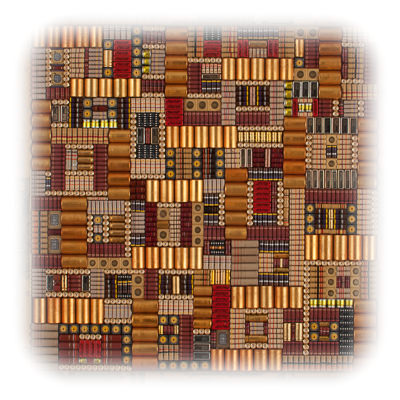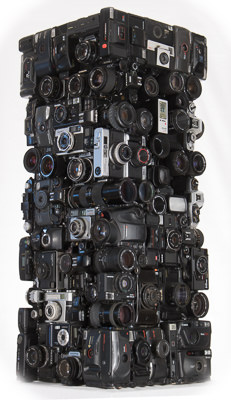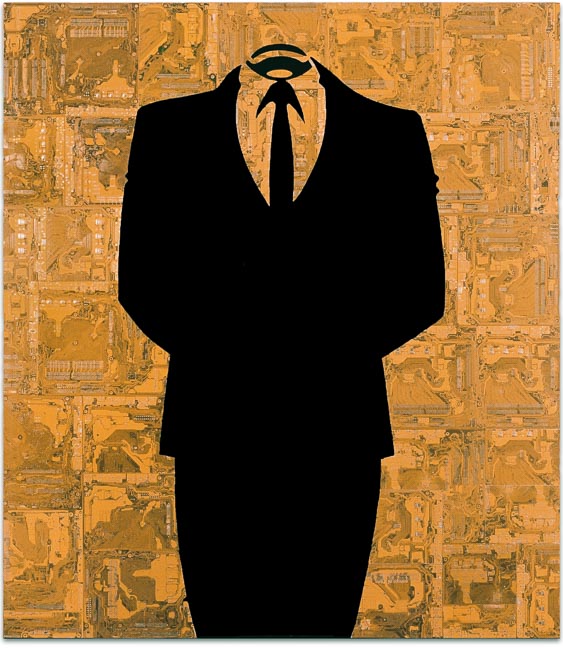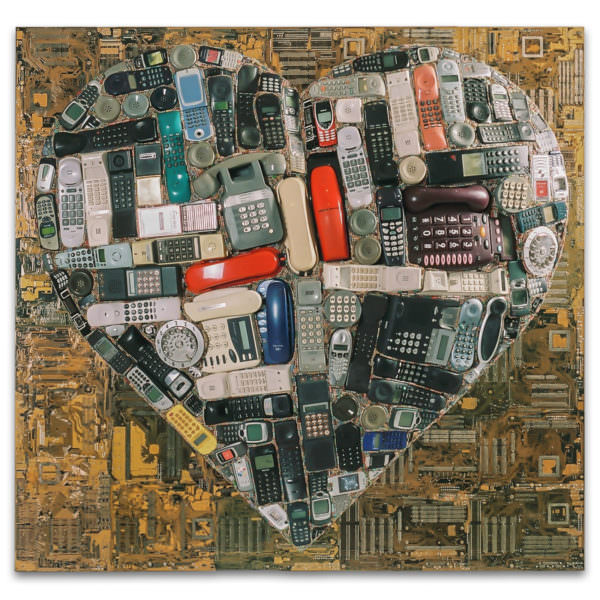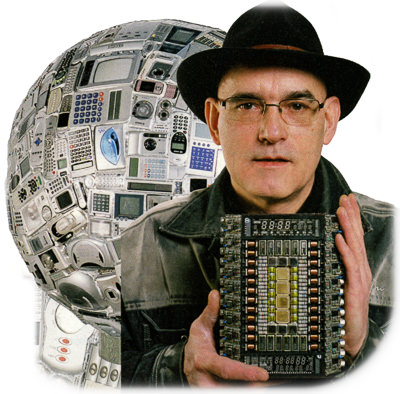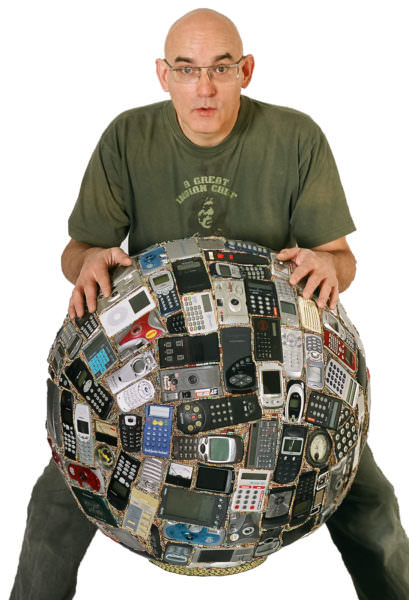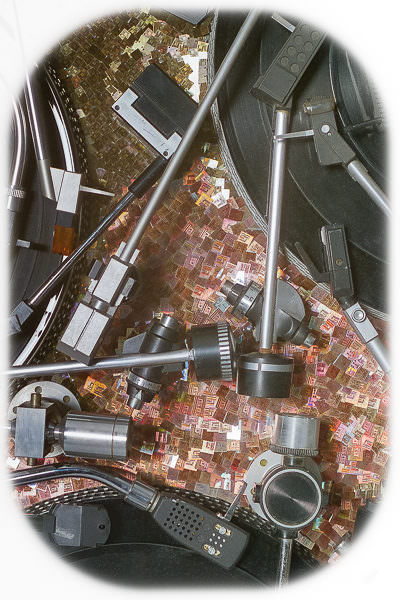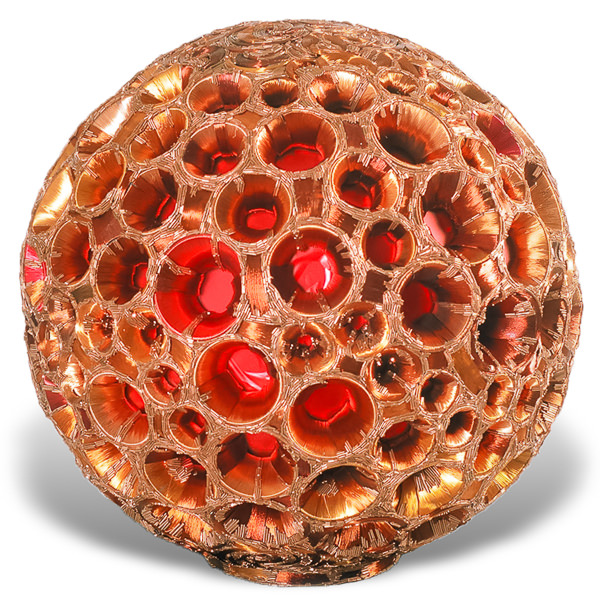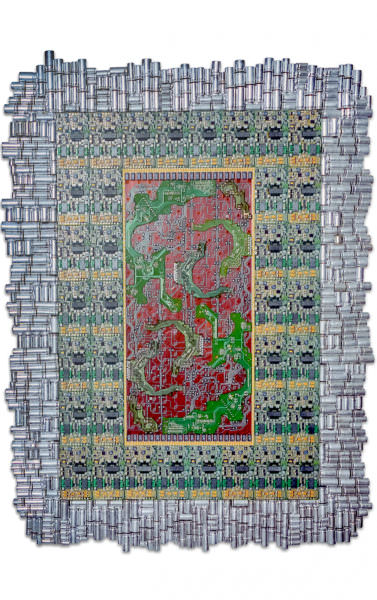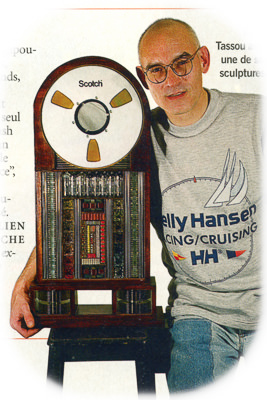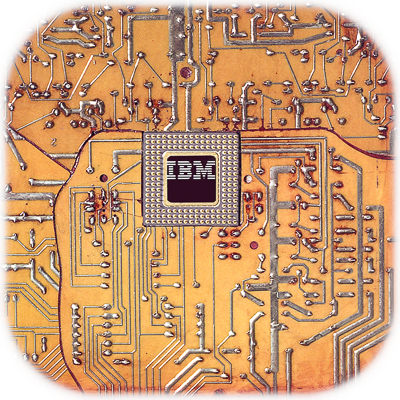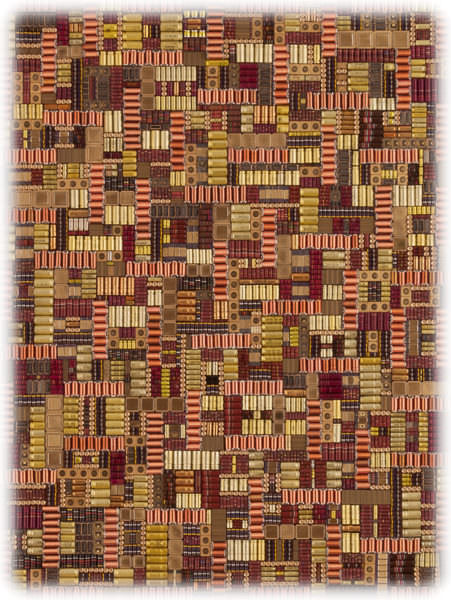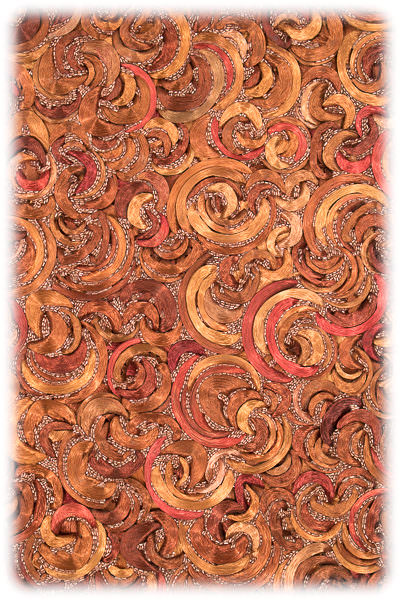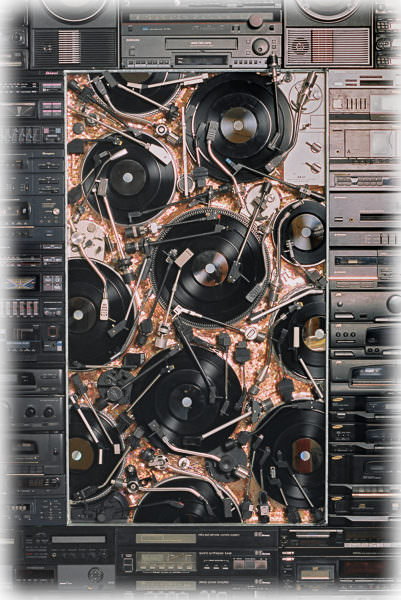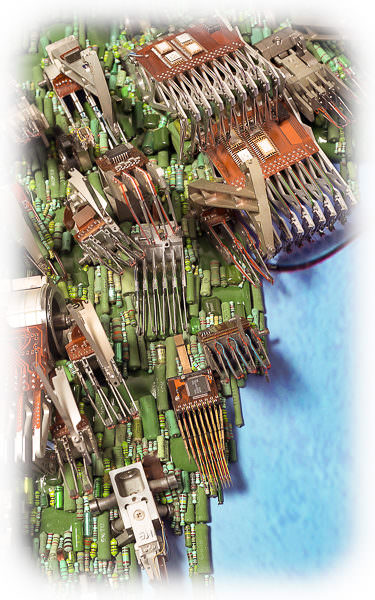Here are the main criticisms
2019. Julie Fortin
2012. CRDP de Versailles
2013. Robert Hopkins
2011. Violaine Brissart
2010. Annick Mambon
2008. Laurence Argueyrolles
2007. Michel Serpin
2001. Janny Plessis Lumeau
1998. Julien Kostrèche
1998. Sophie Bouniot
1998. C.M
Julie Fortin – Philosopher – June 2019
“There is no past or future in art. Art which isn’t present will never be” Pablo Picasso.
If art can cross time, styles, influences and other currents, it is nonetheless in perpetual mutation. It reflects the evolution of techniques, materials, technologies. Art is inspired by society and its contemporaries. It is timeless but fits in its time and leaves its mark on it by its influences, trends and declensions.
The advent of cybernetics has been a well-known social marker since the end of the twentieth century. Technological objects have taken a prominent place in our lives, sometimes even replacing man and creating in him new desires and possibilities by making possible today the impossible of yesterday. And tomorrow ?
The Cybertrash movement provides an answer through the subtle assembly of electrical and electronic components intended from their genesis to an obsolescence programmed because of technological advances that take place. Initiated in the 1990s by contemporary sculptor Rémy Tassou, Cybertrash glorifies the waste of these machines that were part of our daily lives by revealing their hidden beauty so often ignored until then.
I discovered Rémy Tassou’s work almost a year ago.
At first somewhat astonished by this innovative art, I became more interested in his work. I discovered a beauty at first unsuspected because the eye is conditioned to see the pieces that make up these artistic puzzles in their original environment.
The artwork “Nikon” is the one that impressed me the most. This impressive totem is an assembly of silver cameras now collectors and testifies to the technological breakthrough that marked the advent of digital. This work symbolizes the cybertrash by its raw size, the cameras are assembled in their entirety to form a harmonious mass. Passionate about pictures, this timeless work represents in my opinion a photograph of the evolution of cameras.
The wall sculpture called “Roadrunner” also caught my eye because it shows another side of Cybertrash. Square-shaped with golden tones reminiscent of classical works, it is divided into distinct levels intertwined with each other in a resolutely modern style. The contrast is striking between the meticulous structural articulation of the work and the aesthetic restitution performed by a combination of multiple components (capacitors, resistors, etc.) from different electronic parts.
Moreover, the art of Tassou is fully in line with the ecological concerns of our time by offering obsolete electronic objects a surprising but beneficial form of recycling. The fact that the raw material of this art is drawn from existing objects limits consumption and shows the way in terms of resources used. This is especially true when you see the final result on these totems and other wall sculptures.
Rémy Tassou’s artistic work has already given him many opportunities, but I think that his works and the cybertrash movement should get kown and reknown, both for their artistic quality and for the eco-responsible approach it contributes to.
Robert Hopkins – Journalist – Engadiner Post – July 13th, 2013
Rémy Tassou is currently exhibiting a selection of his strikingly original works in Switzerland for the first time, and, rather appropriately, he has gone straight to the top, for this exposition is at no other than the prestigious Suvretta House Hotel in St Moritz at 6,043 above sea level.
On one other occasion a decade ago on the same premises, the German watchmaker Glashütte exhibited a selection of its time pieces and on view was a blown-up version of the workings of one of its products in all its mechanical glory.
Through its size it was quite impractical, but there was great beauty in its asymmetrical functionality.
It seems Tassou, too, knows what appeals the Swiss psyche, namely orderliness, precision, technology. For his works are functionless, too, yet they all appear as if they have been removed from some highly sophisticated piece of high-tech hardware. More than this, they exude a form of beauty alien to the natural world, but beautiful nevertheless.
Old circuits and other electrical parts have all been carefully arranged to enable the viewer to forget their intended purpose and just concentrate on their simple beauty.
Some have been framed in traditional gilded frames, other works are free-standing like totem poles.
Either way, they would fit in with the most modern interior decor, or make a striking statement in more traditional surroundings. What is more, each one can look quite different depending on the way it is lit.
It is no wonder so many of Tassou’s works have been sold in cities of such widely different cultural backgrounds as London, Kuwait, Moscow and Singapore.
Centre Régional de Documentation Pédagogique de Versailles. – Revue Docsciences – 2012, October.
Telephony-based wall sculpture and motherboards,
129 x 123 x 17 cm, 42 kg.
The object manufactured in art has its tradition: Pablo Picasso invents collage in 1912, Marcel Duchamp creates his first ready-made in 1913. Other artists choose used objects: Kurt Schwitters collects old paper, Pierre Buraglio works with window frames and Arman raises bins to the rank of works when Jean Tinguely recovers old wheels. Today, the technological object is outdated and doomed before being worn out.
The artist Rémy Tassou disembowels him and composes accumulations with his guts: he draws a protean work with abstract and ornamental motifs where sculptures, columns and wall reliefs intersect. With cybertrash art, Rémy Tassou gives birth to the new icons of a civilization that reveres its technology.
The work is frontal. On a golden background almost monochrome stands out the form with contrasting values, punctuated by some saturated colors. The viscera of the machine compose the background, its envelope the pattern.
Multiple analogous objects are juxtaposed. They represent a unique sign without any link with them but a set of formal rhymes brings them together: the drawing of the heart redoubles the curves and lines of the handsets.
In addition to seeing, the object engages the touch, the word, and the other through the handset.
Violaine Brissart – Recyclages Récupération – N°6 – February 2011
Rémy Tassou. Cybertrash sculptor.
Rémy Tassou dissects the guts of computer machines. In his workshop Grasse, electrical and electronic components metamorphose into sculptures and totems.
All day long, Rémy Tassou juggles balance sheets and income statements. But it’s the evening he comes to his true passion: electronic components. “Electronics was born in 1945, and I, ten years later, the appearance of these materials coincides with my presence on this planet,” he says, convinced that the invention of electronics is as important than the discovery of fire. Fascinated by these colorful and aesthetic materials, he dismantles with curiosity electrical and electronic objects and exhibits his findings. When invited to dinner, he enjoys replacing the traditional bottle of wine with a bottle filled with memory sticks. “Such a bottle has a computing power superior to any computer!”, He jokes. The apprentice artist notices that his friends keep his presents. Better: they highlight them in their living room.
The concept of cybertrash is born. “To create is to do something that does not exist.” By taking hold of a material that previous generations could not have imagined, many possible creations were offered to me. to confront an art such as painting … “, he judges. When the Reuters subsidiary he is working for restructured in 2000, he became a full-time sculptor. He moved to Grasse and began to recover mobile phones, cathode ray deflectors, capacitors, microprocessors, resistors, fuses and other motherboards in the waste disposal centers. He sorts them meticulously, by color, and transforms them into his studio-gallery.
A work like Second Life summarizes its approach, offering three possible readings: aesthetic, ecological and historical. “This chrome planet made up of home electronics represents a reflection on the recycling of WEEE (Waste Electrical and Electronic Equipment: Ed) on the entire planet.This is also a plastic research that gives to see a material that we do not usually see.
Finally, my work is the memory of a cybernetics doomed to obsolescence barely elaborate, explains the artist. Ultimately, the electronics will be totally invisible. My sculptures are heritage works because they are destined to disappear. Most of the components I use are no longer manufactured … “.
These “antiquities of the future”, which are exhibited in various galleries in the south of France, have also joined the walls of collectors, including Karl Lagerfeld.
Annick Mambon – Nice-Matin – 3 juin 2010
Contemporary art, when Rémy Tassou recycles.
In the hands of Rémy Tassou, recycled objects become the basis of sober and eloquent works of art.
For three years, Rémy Tassou tried to convince radio listeners that ” there is no more beautiful collection than a collection of contemporary art “. Taking up Dubuffet’s reflection, according to which ” art must arise where we do not expect it “, the cybertrash artist, installed place de la Poissonnerie, exhibits his sculptures permanently in Saint-Paul-de-Vence, Art Seiller gallery, but also, lately in a place to say the least unusual: the glass roof of the Center Leclerc. ” Contemporary art has its place in this type of structure !” And these eight sculptures, including two more than 200 kilos, were appreciated by the public and the clientele, whether you are an art lover or not … or sensitized to waste management.
From the laptop to the work.
Thus, the Syndicat Intercommunal of Valorization of the Waste of the zone Cannes / Grasse, had appealed to him. “I find that organizing a collection of small electronic and electrical equipment is a clever move. This waste is an environmental problem. Incinerated with household waste, they are dangerous. But become harmless from the moment when sorted, they are recycled by industrial”.
By depositing his expired mobile phone, we make a concrete and humanitarian gesture and we participate in the development of a sculpture !
He decided to take the opposite of these artists who show striking and aesthetic images taken by helicopter.
According to Rémy Tassou, ” the great tenors of the protection of the planet communicate on fear. A change of registry is desired, because the crisis has weakened many people, and there is no need to add”.
That’s why the triad ambassadors joined the artist by offering their solutions to the eco-citizens.
Laurence Argueyrolles – Télérama – n°3052 – July 2008.
Crazy
Tassou. The exoplanet.
His sculptures, assembling electronic components and musical material, bear witness to our times. Astonishing.
Wondering what to do with your 8o transistor? No more worries: Tassou recycles, Tassou transforms, and beautifully! He is the only one in the world to practice what he has now called for fourteen years the “Cybertrash”. These totems or wall sculptures are made only with electronic components. The choice of this material is for Tassou a certain universality: it is found in the four corners of the world, in the belly of very different objects. Their viability is restricted.
Composing a work from cathode-ray tubes will quickly become a challenge for this artist who works the series! He goes through the dump sites, the manufacturers and also relies on donations. His studio is full of tiny pieces from all over, arranged by color, tone and type in small jars. Tassou spends hours there, a meticulous and passionate work for this Parisian, who has been posing for five years his memory cards and other arms of record players in Grasse.
For four years, more than 250 artists in the making confirmed or affirmed, have succeeded. Six months of waiting are required to expose at night on rudimentary panels installed around the old cast iron hall. “The art market is too opaque, the young artist who arrives in Saint-Paul-de-Vence is immediately repressed by gallerists,” said Tassou. Here he can judge the impact of his work on the public.
“The confrontation is uncomplicated, it allows to question sometimes.” The visitors leave with goodies, small elements created by the artist invited for the occasion, then distributed as “first element of his collection of contemporary art”. A way to demonstrate that art is priceless!
Michel Serpin – Sophianews – February 2007
Tassou sculpteur cybertrash
Magic because complex, today’s electronics is however perfectible. So perfectible that, says Tassou, she will be invisible tomorrow. Therefore, all the work of memory is to be done during this period of visibility “hyper brief” in the history of Humanity, since it extends only from 1945 to 2050. The “Cybertrash” of Tassou is therefore to use the scraps of cybernetics to bring them to life in other ways.
It is in Grasse that for three years, Tassou, native of Nantes, realizes his works, celebrating the real beauty of electronic components that will emerge in space in the form of wall sculptures or, in three dimensions, totems. “Unique sculptures and totems that record the memory of obsolete technology from the very beginning”.
Because there is no artistic expression without ties and true talent is also to pay tribute to those who have opened ways, Tassou is recognized in the wake of César and Arman who have accustomed the public eye to certain forms: compressions for Caesar and assemblage sculpture for Arman. Now remains to create a dynamic, to impose a style so that, beyond the world of collectors, a large audience is passionate about cybertrash sculpture.
Keeper of the Garden of Remembrance, guardian of an intrinsic beauty and magician, Tassou believes that “interesting sculpture when it can not be painted or photographed”. We can only name it … Keyboard … lrridiun. And it’s whispering like first names of science fiction heroines …
Works visible every day at the artist’s studio: www.tassou.com. 4 place de la Poissonnerie in Grasse and from March 28th to April 8th during the Tassou exhibition at Lavoir de Mougins.
Janny Plessis-Lumeau – LMS news – September 2001
“The cybernetics antique dealer”
Remy Tassou exhibited his work at the Salle Saint Esprit in Valbonne last June. Caught up in a unique adventure since 1988, this 45-year-old from Nantes, now settled in Paris, has paved a new way in contemporary art. A science fanatic and former businessman, be is the founding father of ‘Cybertrash’, the ostensible purpose of which is the glorification of computer waste. Sophia Antipolis, the NICT Science Park, is therefore the obvious place to display his artistic work.
So here we are at the heart of the electronic chip, on a voyage of discovery into microprocessors that have been catalogued, analysed and classified before becoming works of art, wall paintings or totems. Wall sculptures of such significant weight (“Driver” weighs in at 10 kg) clearly represent much more than a simple assembly of salvaged parts.
Well before him, Cesar. Annan and Ben had engaged in the art of amassing, piling and crushing. But Tassou strives, above all. for aesthetic quality. He loves beauty, and that is what attracts the eye to these strange assemblies: the harmony of his colours and shapes could leave une thinking they had been created solely to be part of the final tableau.
Over and above style, Remy Tassou also makes a statement about the extraordinary world of cybernetics.
And it is moving to rediscover, in middle of a piece of work, the names of forgotten figures such as “Wheastone”, the famous inventor or that of “Nixdorf”, whose body and soul were swallowed up by the powerful Siemens. These works, which are mainly computer memories, hold thousands of data from our era, from then- former activity, and from the runaway business of information technology. They are destined to become the antiques of tomorrow, the hieroglyphics of the 3rd millennium doomed to oblivion save for the helping hand of Tassou.
The artist is exhibiting at the “Opera Gallery”, in the grand Saint Germain room at the Hotel Lutetia and at”Art Sept” on Promenade des Anglais à Nice. A few of his works are also on display in New York and Singapore, but Remy Tassou is used to the warm welcome he always receives in Valbonne and at the Fondation Sophia Antipolis where he regularly exhibits. Tassou’s quest is incessant. His oeuvres are endlessly reworked, and now that he has fully mastered the technique, his assembly is precise, the frames full and the relief marked. Anticipating the future of computer science, he can only greet with enthusiasm the arrival of a human vocabulary in cybernetics. For we now speak of plasma screens, soft memory and (why not) the use of live cells in “neuroprocessors” which, according to the artist, represent the fusion between the human neuron and the microprocessor.
So who said the world of computers was devoid of poetry and charm? Remy tassou has just created a new work called “Hip”, an erotic-cybernetic assembly, inspired by a lady dressed in lace… And as we all know, lace has always inspired artists, even those who specialise in cybertrash!
Julien Kostrèche – L’Evénement du Jeudi – Décember 1998
Rémy Tassou, artist “cybertrash”
During the day, Rémy Tassou, 44, works in finance. But at night, he wanders the streets of Paris in search of corpses of microcomputers or electronic devices abandoned on the sidewalk. The machines that work do not interest him: “I prefer to look at them when they have given up the soul, to strip them, feed me from their bowels and free them from their cybernetic coping”. Clearly, this artist “cybertrash” recovers thousands of components and connects them to each other to compose wall sculptures and colorful totems. “I’m ecstatic about their inner beauty, because some components graze goldsmith”. We understand better why the artist secretly dreams of being able to someday “trasher” a satellite or military electronic equipment for which gold and platinum are frequently used.
One would be surprised that the only cybertrash artist on Earth is a French, because “the ‘made in France’ is almost non-existent”, he says amused.
Sophie Bouniot – L’Humanité – October 1998
Rémy Tassou, cyber-artist
Rémy Tassou has provoked the intrusion of the imaginary into the universe of components of the microcomputer, telephony or electronics, which allows to release the classic structures of their assembly.
At first, it is for the artist to disassemble industrial machines, in order to extract the substantive marrow: their components. The artistic approach is extended in the unification, the link by a plastic relationship of these components in wall sculptures or totems. IBM 4869, Input, Laser, Rack, Dolby, Sodium or Luminescence are the result of this work. These works are elaborated in glass volumes filled with components whose classification is established by natures and by colors. The materials concerned by the “cybertrash” are surrounded, the limit between what is cybertrash and what is not being extremely palpable.
The works are a rigorous and methodical accumulation of cathode ray tubes, hard disks, vinyl records, sodium vapor lamps, deflectors, engines of household appliances, etc. The inspiration of the artist is not clear and precise, it goes through the phase of disassembly, inventory management, creation and finishing. There is an empirical side in the conception of his works, they each constitute an aesthetic and technical stage, which calls for a consecutive and perpetual inventiveness.
Rémy Tassou metaphorically compares his artistic approach to a ride in the mountains. “We start to choose the theme of the play as we would choose his mountain, then we take out his cards before starting the climb.It’s the same principle as sorting the components that we will use. from the beginning of the race, then it is lost in the undergrowth, in the back roads, but it remains the goal to reach.The design of a piece is an identical approach, a slow but rigorous progression. The originality of the research associated with a concern for architectural perfection and a sensual care given to the composition undoubtedly define the “cybertrash”, an art that arouses curiosity and enthusiasm.
C.M. – 1998
In 1954, on Whit Monday, crunching an apple previously coated with cyanide, Alan Turing commits suicide at 42; the day before, he was working like every week on the University of Manchester computer, one of the two specimens existing then. From the first article of formal logic published in 1934, then designing the famous machine to decrypt that will ensure Allied intelligence services supremacy during the Second World War, finally developing for the magazine “Mind” in 1950 a “game of the ‘imitation’, which founded the principles of artificial intelligence, he had helped to create cybernetics. As for the crunched apple, the computer industry has given it the fortune that is known as a posthumous tribute to the one who allowed computers.
The progress in the compilation of data, thanks to the miniaturization of transistors, a major feature of this whole discipline focused on efficiency, should yet stop, we are told, around 2010. We would have exhausted the possibilities offered by the knowledge of modern physics, in the field of technological applications, far from the start, in 1948, of the “machine-baby”, this gigantic set of 12 consoles filling an entire room and for the operation of which the least adventurous insect was a danger.
Between the two so little time has passed … But a revolution has taken place thanks to a considerable change in the conservation of data and the transmission of information. The “Galaxy Gutenberg” has probably given way to the “Marconi Galaxy” since we perceive our global environment daily as a “global village”, as predicted by Marshall Mc Luhan. This perception, however, hardly reaches reality beyond the surface of the images. It is more radically that the transformation operates, deciding more resolutely our relationship to the world.
Cybernetics governs things and beings, as well as the Greek etymology, “kubernêtike”, reminds us. This science of regulatory mechanisms, servomechanisms, this science relating to communications, to their regulation, has generated powerful machines whose extraordinary efficiency and gigantic capacities have appropriated space by defining a time of their own.
This endangering of mankind by the automata that she invented quickly became a central theme of world science fiction: cybernetics, by creating the new universe in which we must live now has thus renewed a part of our imagination.
In this frame that the circulation of coded information constructs, in this crossed dialogue of computers, this impalpable fabric of the computer network, a cosmography takes shape with unknown contours, with improbable reliefs, as difficult to grasp as it has been in the eyes or to the very consciousness of the man of the Renaissance the planisphere which is now familiar to us. The concrete reality, the one that is experienced daily, that is awkwardly explored as uncertain experiences and tried-and-tested knowledge, seems to fade in favor of the virtual construction imposed by cybernetic tools become almost autonomous. The environment of each is no longer measured by the senses, it is produced, as an object, by a technology whose control, if not the use, is inaccessible to most …
Yet, if all this is true, it is also too simple; cybernetics announces neither the end of time nor the end of history; it forces us to rethink what we are, to redistribute tasks and knowledge, to rethink speed and communication, but it also makes it possible to discern invisible vanishing lines before it. Given the worst of it, the immediate control of the activities and displacements of each one, that it makes possible or probable, playful forms of its appropriation appear, very different from the games programmed for the consumption of which is summarized more often the use of family computers.
All, however, place the artistic activity as well as any other human activity today in the dependence of these machines which we know are, like the “machine-baby”, at the mercy of a “bug” , a bug, or simply a malfunction related to fatigue or wear or breakage of one of their components. Consider the practical as well as the aesthetic and even moral difficulty facing a museum curator when a failure of a specific model of a TV monitor renders a Nam June Paik installation permanently inert. These new artistic practices have seized the tools of the century without working the obsolescence of these, deliberately neglecting their fragility, when it is not assuming it since they exhibit a constrained dimension of our contemporaneity. What is a computer otherwise the unstable assembly of electronic products constituting, in their final stage, a set of waste specific recycling problematic?
But these offer in terms of shapes, the touch of textures, which belong only to the new age that we share with our machines “to govern” … In the same way that in their time the New Realists have chosen to confront the eye, the hand, the imagination of the artist to the products of the industry passed from consumerism to oblivion, Rémy Tassou will be interested in the bins of cybernetics, “Cybertrash cans”; picking up, picking small things, tiny parcels escaped from the shattered carcasses of televisions, hi-fi systems, outdated computers, uncertain monitors or sophisticated devices, abandoned to a new process that was supposedly definitive, the one waste, shredding of landfills or de-manufacturing of recycling …
In itself the collection thus constituted, infinite, as much as manic, could display an aesthetic principle, in the reappropriation of an electronics passed beyond the system, inactive, crumbled … The collection is composition, poetically, reaffirming the pre-eminence of the living by the elementary gesture, which repeats, undoes, classifies and assembles series that no longer respond to the cybernetic necessities but to the joyful ones that Tassou invents in an operation that is accomplished thanks to the multiple beauty of the components, the unpredictable diversity of industrial and geographical origins.
To collect as patiently what, scattered, neglected, should have disappeared, is to proceed to an archery with indecisive limits. Every week, Tassou finds new components with shapes, colors, unexpected materials … Yet this memory of computer science and information mechanisms is probably worth less by the archeology it announces than by the aesthetic jubilation that can to accompany.
Each of these objects, tiny or massive, isolated from the ensemble to which it seemed to belong only, is revealed to itself; shape decided by a now forgotten function in favor of the possible seduction of the look that the colors will stimulate …
And then there are the same materials: silicon, aluminum, europium, cadmium, copper and also gold, silver, fine alloys protected by the industrial secret … Every electronic waste is the small part of a treasure appropriated by Tassou, whose works thus have a scornful and perhaps even slightly dangerous wealth, since it is not always known what effects on human health are induced by the manipulation of apparatus in the constitution which included these components …
Soon, however, the decomposed organism, broken down into its constituent parts by its very obsolescence, will be reconstituted to produce a new object, in the crafty and meticulous handling of the pieces, neglecting the original operating principles, those which gave meaning and function to the machine of which only the fragments remain. The work of Tassou then brings out abstract volumes or affecting the appearance of unexpected androids, Cybertrash objects that expose the collection while stealing, beyond without denying it. What has become of the machine? What will the attention be on? What was all this good for? What is this strangeness made of?
Each electronic component is at once active in its belonging to the organism to which it was indispensable, and inert since reduced to its mere materiality, derisory and vain, from the day of its abandonment to the trash of cybernetics. But the seductive irony of Cybertrash is mainly due to the prolongations of this reconstruction; the passive mass resulting from the assembly would still be innervated by unnoticed forces, fluids and moods of the destroyed machine. Some of the components used by Tassou are little more than ducts, places of passage, mute, although one can suppose, at least poetically, that this passage even left a trace one day perhaps discernable … D ‘ others, on the other hand, are holders of buried secrets, blocks of data enclosed in silicon, microscopic spaces saturated with information, knowledge. All assembly born of aesthetic intuition is the refuge, the mask of these secrets, constituting a cryptogram in the manner of sand paintings which for the informed eye of the aborigine say much more than the pleasant effect that perceives the Western. Abstract composition, carcass of mutant insect, cyborg at rest, each object, below the appearance that it offers to who contemplates it, would thus be activated in the mystery of its structure. Thus, in the Cybertrash, what is stolen, inaccessible if not perhaps to archaeologists of the future, is confused with what is exposed, the materiality of computer science, electronics.
Decided by the chance of discoveries, carried by “creative intuition”, never any piece is the result of a preliminary tactical calculation, the outcome of a thoughtful plan. Tassou has the habit of distinguishing the creative and the artist, the first developing all the possible solutions, the second always making the right choice … It is about manifesting an invention, in the double meaning of the word, the time elaborating something new and revealing what, buried, remained unnoticed. In this world reconstructed by cybernetics, Tassou hears, little by little, modestly in each of his works, to give shape, irony and fascination mixed, to the relationship that man has with his products … Obviously, working with the waste what claims to cancel duration for the benefit of immediacy is to work on time; so much so that Tassou simply defines his activity as “a hobby that avoids boredom” … Yet he also speaks of “working quickly by not doing the same thing twice, avoiding unnecessary things”. It is true that his pieces show an art in the old sense, combining the concerns of the artist and the care of the craftsman.
Therefore, one can understand that Tassou observes with lucidity, without distrust and without illusions, a market where, he says, “the contemporary art does not sell but is bought, confidentially” …
In 1991, this work began solitarily, without reference, by accumulation and diversion; in 1996, the Arnoux Gallery in St Germain des Prés welcomed him; this recognition is decisive: since then personal exhibitions and participations in collective exhibitions are multiplying, punctuated by interventions on Canal + or Arte. Provincial again after being a long time Parisian, Tassou has chosen to show his work in all the places that open to him, since, as well, computing is everywhere. And he continues, stubbornly, his astonishing inventory of what is happening to us … Yet, when he titles a sculpture “Neuroprocessor”, he points himself to the limit of the Cybertrash, intimately related to our time as the ephemeral materials of this “stone age” of computer science. We are already talking about “plasma screens”, “liquid crystals”, “soft memories”, experts promise us for a near future of new computers, molecular, DNA or quantum: new forms are to be born, others Also new forms are to invent …

